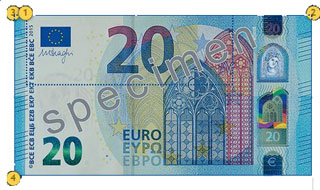Currency index
Advertisements
Twenty Euro banknote(Europa series)

Quick links to banknotes
Europa series:





First series:







Design
Description:
Size: 133 x 72mm
Paper type: Cotton
Main color: Blue
Architectural style: Gothic


The Twenty euro banknote (€20) depicts bridges and arches/doorways in Gothic architecture. The design contains the denomination, the signature of the president of the European Central Bank, the European union flag, the EU flag stars, description of EU overseas territories and the initials of ECB in different european languages.
On 24 February 2015, the President of the European Central Bank (ECB) Mario Draghi, unveiled the new 20 Euro banknote at a press conference at the ECB's new headquarters in Frankfurt am Main, Germany. The new banknote is part of the new Europa series, named after a figure from Greek mythology. The design of the new €20 note has had a radical overhaul and should prove much more difficult to forge. The Eurosystem started issuing the new 20 Euro banknote on 25 November 2015.
Security features
Security features can help you to tell if your Twenty euro note is fake or real.
Feel the new 20 euro note

1.The banknote paper consists of pure cotton fiber, which feels crisp and firm (not limp or waxy).
2. Raised print
Feel the banknote. On the obverse of the note, there is a series of short raised lines on the left and right edges. To feel the raised print, run your finger over it or scratch it gently with your fingernail. The lines make it easy to identify the banknote, for visually handicapped people. The main image, the lettering and the large value numeral on the front of the banknote also feel thicker.
Look at the banknote against the light. The portrait window and watermark as well as the security thread become visible.

1. Portrait window

Look at the banknote against the light – the window near the top of the hologram becomes transparent and reveals a portrait of Europa on both sides of the note. When the banknote is tilted, the window also shows rainbow-colored lines around the value numeral. On the back of the banknote, rainbow-colored value numerals appear in the window.
2.Portrait watermark


The watermark is produced by varying the thickness of the paper. A faint image becomes visible and shows a portrait of Europa (a figure from Greek mythology), the value of the banknote and a window appears when you hold the banknote against the light. If you put the banknote on a dark surface the light areas become darker. This effect is very easy to see in the value watermark. The portrait also appears in the hologram.
3. Security thread

The security thread is embedded in the new 20 Euro note paper. Look at the banknote against the light. The security thread appears as a dark line. The € symbol and the value of the banknote can be seen in tiny white lettering in that stripe.
Tilt the banknote. The silvery stripe reveals a portrait of Europa in a transparent window and the emerald number displays an effect of the light that moves up and down.

1. Portrait window


Look at the banknote against the light – the window near the top of the hologram becomes transparent and reveals a portrait of Europa on both sides of the note. When the banknote is tilted, the window also shows rainbow-colored lines around the value numeral. On the back of the banknote, rainbow-colored value numerals appear in the window.
2. Portrait hologram



Tilt the banknote. The hologram – the silvery stripe on the right of the note – reveals a portrait of Europa (a figure from Greek mythology) as well as the € symbol, the main image and the value of the banknote.
3. Emerald number

Tilt the banknote. The shiny number in the bottom left corner of the note displays an effect of the light that moves up and down. The number also changes color from emerald green to deep blue.
Additional security features

1. Microprint


Some areas of the banknote feature a series of tiny letters. This microprint can be read with a magnifying glass. The letters are sharp, not blurred.
2.Standard UV light (obverse)

- Banknote paper absorbs the UV light
- Small fibers embedded in the paper appear. Each fiber shows three different colors- yellow, blue and red
- The stars in the EU flag, the small circles as well as the large stars glow yellow. Several other areas also glow yellow.
Standard UV light (reverse)

- Banknote paper absorbs the UV light
- Small fibers embedded in the paper appear. Each fiber shows three different colors.
- A quarter of a circle in the center of the banknote as well as several other areas glow green. The horizontal serial number and a stripe appear in red.
3. Special UV light (UV-C)

On the front, the small circles in the center glow yellow, the large stars and several other areas glow orange. The € symbol also becomes visible.
4. Infrared properties

Under infrared light, on the front of the banknote, only the emerald number, the right side of the main image and the silvery stripe are visible. On the back, only the value numeral and the horizontal serial number are visible.
Check this video of fake 20 euro note
Sources:
European Central Bank
wikipedia.org




Follow currencyguide.eu